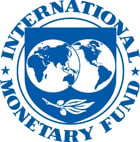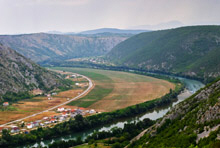
Typical street scene in Santa Ana, El Salvador. (Photo: iStock)
IMF Survey: Bosnia and Herzegovina Gets €405 Million Loan from the IMF
October 5, 2012
- Delayed reforms hinder growth while eurozone crisis still threatens outlook
- New program aims to counter risks, maintain economic stability, boost growth
- Challenge is to limit current expenditure, allow more capital spending, target social spending
The IMF’s Executive Board approved on September 26 a 24-month €405 million Stand-By Arrangement for Bosnia and Herzegovina. The program will help create the conditions for a sustained economic recovery amidst the difficult economic environment, the IMF said.

Mostar Citluk region, Bosnia and Herzegovina. A key challenge facing the country is to increase capital spending, including on highways (photo: Per Karlsson/Danita Delimont/Newscom)
EMERGING EUROPE
“The main aim of the program is to counter the effects of the euro area crisis on the economy of Bosnia and Herzegovina, while at the same time address the structural challenges that the country faces,” said Costas Christou, IMF mission chief for Bosnia and Herzegovina.
A part of the former Yugoslavia, Bosnia and Herzegovina went through a traumatic transformation during the 1992–95 war, which caused immense human suffering, destruction of infrastructure, and an almost 80 percent decline in GDP.
The Dayton Peace Agreement that ended the war in 1995 divided the country into two largely autonomous Entities: Republika Srpska and the Federation of Bosnia and Herzegovina, itself divided into ten largely ethnic cantons, which exercise most economic power; and a State government with a limited mandate.
Faced with unfavorable external economic environment and weak policy coordination on the national level, the Balkan country is struggling to find a path toward sustainable growth and job creation.
Speaking to IMF Survey—the IMF’s online magazine—Christou discussed the economic outlook, and objectives of the new IMF-supported program, and the medium-term challenges Bosnia and Herzegovina faces.
IMF Survey: What are the economic prospects for Bosnia and Herzegovina and how do the risks stemming from the euro area crisis affect the outlook?
Christou: We expect economic growth to start recovering in 2013 after stagnation in 2012. Domestic demand is projected to remain subdued, held back by high unemployment, fiscal restraint and slow credit growth. Given Bosnia and Herzegovina’s strong links to the euro area and neighboring countries, stagnation of economic activity and rising financial stress in those countries are expected to continue to take a toll on Bosnia and Herzegovina’s growth prospects. All in all, we project modest growth of about 1 percent next year, with inflation remaining low.
However, we see the risks to the outlook tilted to the downside. The majority of the risks come from a possible intensification of the euro area crisis, which could significantly affect growth. Bosnia and Herzegovina has close links to Western Europe through exports, remittances, and capital inflows. In addition, foreign banks, which have a big presence in the country, rely heavily on funding from their parent banks and are not immune to the loss of confidence triggered by events in their home countries.
IMF Survey: The new IMF-supported program is the second for Bosnia and Herzegovina since the global financial crisis started. What is the history of the Fund's engagement with the country?
Christou: The Fund has had a very close relationship with Bosnia and Herzegovina since it became a member on December 20, 1995. On that same day, the Fund approved financial support for the country under a new policy on emergency assistance for post-conflict countries. Bosnia and Herzegovina was the first country to benefit from that assistance.
The last IMF-supported program with Bosnia and Herzegovina was a three-year Stand-By Arrangement approved in July 2009. The last review under that program was completed in October 2010. Because of the political situation in the country at the time and the long delay in forming a new government at the state-level, we were not able to complete any further reviews.
Nevertheless, right after the new Council of Ministers was confirmed by Parliament in March of this year, we received a request and started negotiations on a new program. We reached a staff-level agreement in July and the IMF’s Executive Board approved a new two-year Stand-By Arrangement on September 26.
Beyond financial support, the country has also benefited from extensive technical assistance and training provided by the IMF.
IMF Survey: What are the key objectives of the authorities’ new program?
Christou: The program follows a four-pronged approach.
The first is to improve national policy coordination, which is important in a country with many government levels, like Bosnia and Herzegovina.
The second is to maintain fiscal discipline while advancing structural fiscal reforms. The authorities aim to reduce the size of current expenditure and allow more space for capital spending and make social spending more targeted.
The third is to safeguard financial stability within the context of the currency board, which has served the country very well since it was introduced in 1997. The objective is to further improve crisis preparedness, banking supervision, and resolution frameworks.
The fourth is to intensify reforms to improve the business environment to support growth, investment, and job creation.
IMF Survey: What are the medium-term macroeconomic challenges that Bosnia and Herzegovina has to deal with?
Christou: Looking beyond the immediate challenge of kick-starting the economy, Bosnia and Herzegovina needs to advance its reform agenda. The size of the government is still very large. So the focus should be on reducing current public expenditures, and on improving the targeting of social spending.
In addition, the resilience of the financial sector needs to be strengthened through improvements in contingency planning, and close coordination between the central bank and the banking agencies, as well as better cooperation with home supervisors.
More generally, it is important to address the structural impediments that hamper economic performance, as they are at the root of the country’s struggle to achieve more balanced growth.


